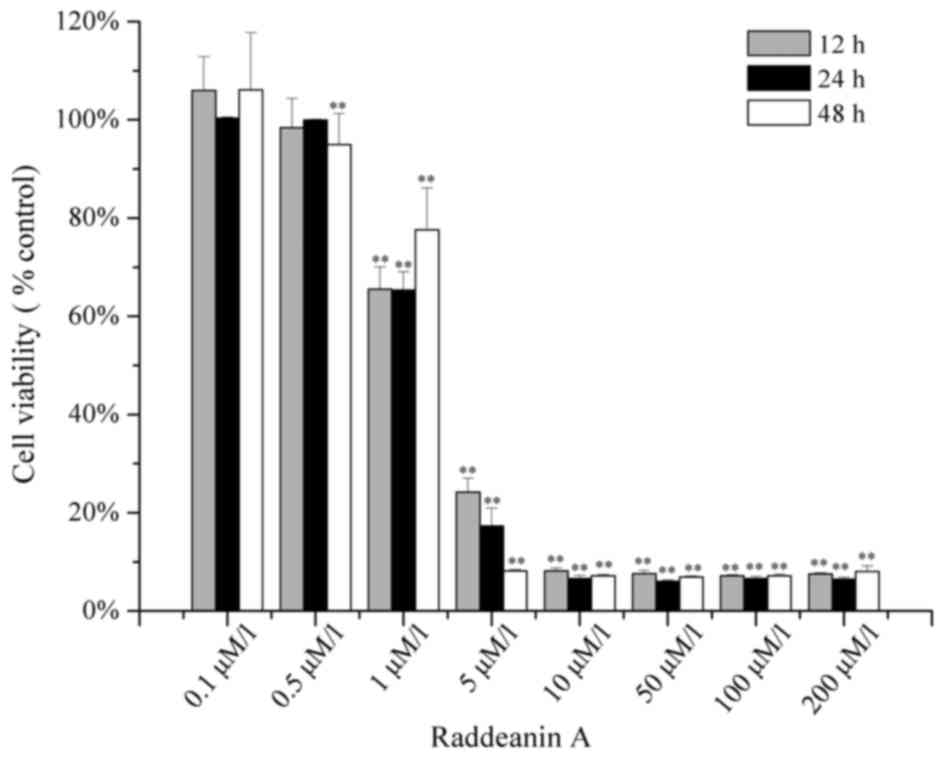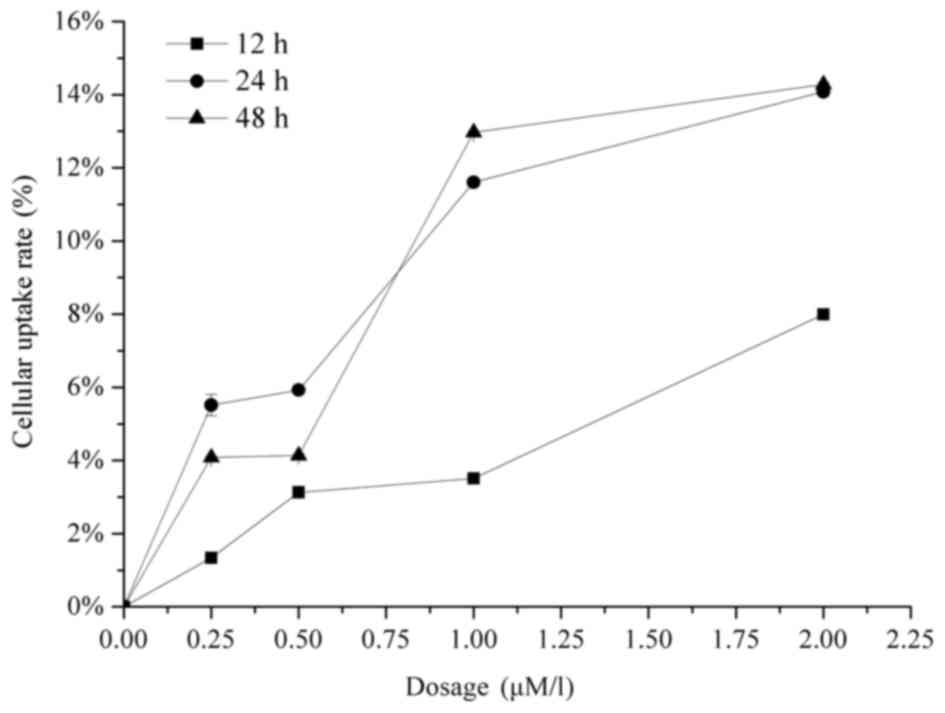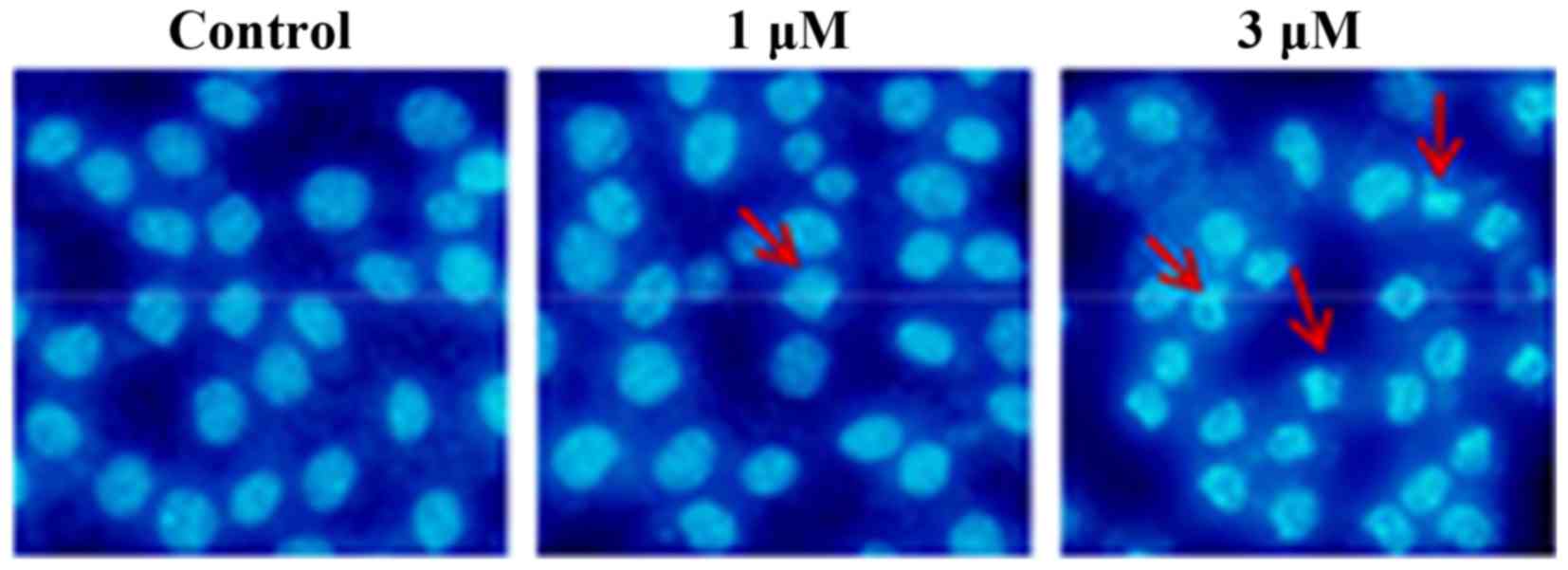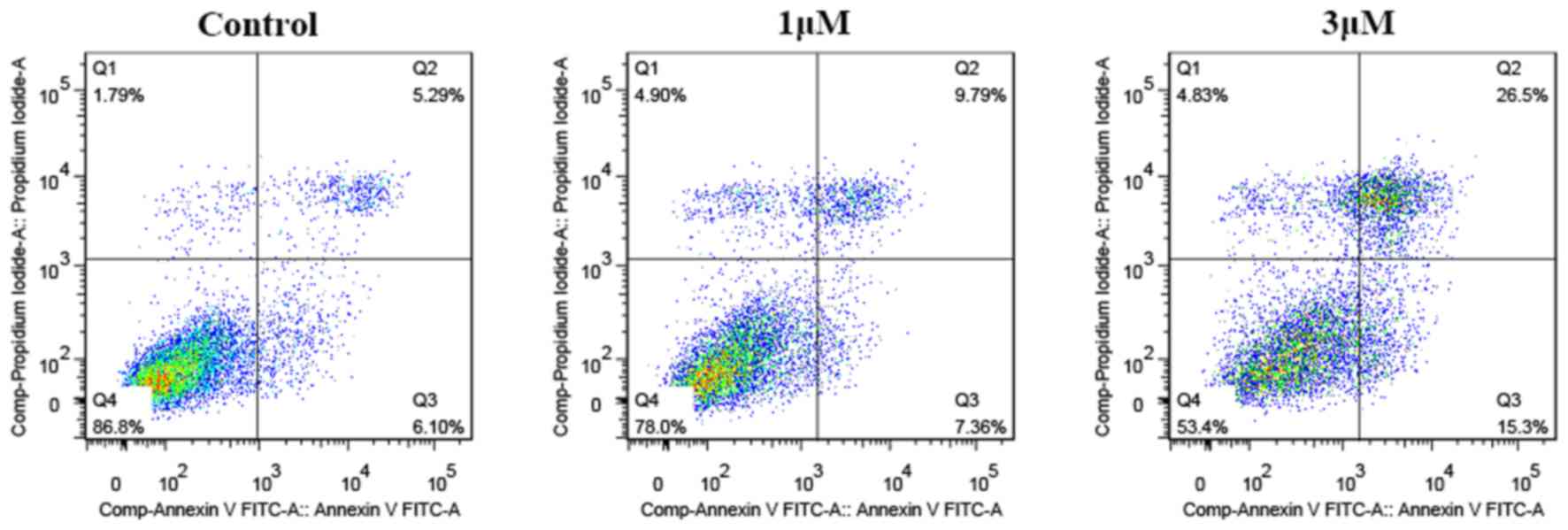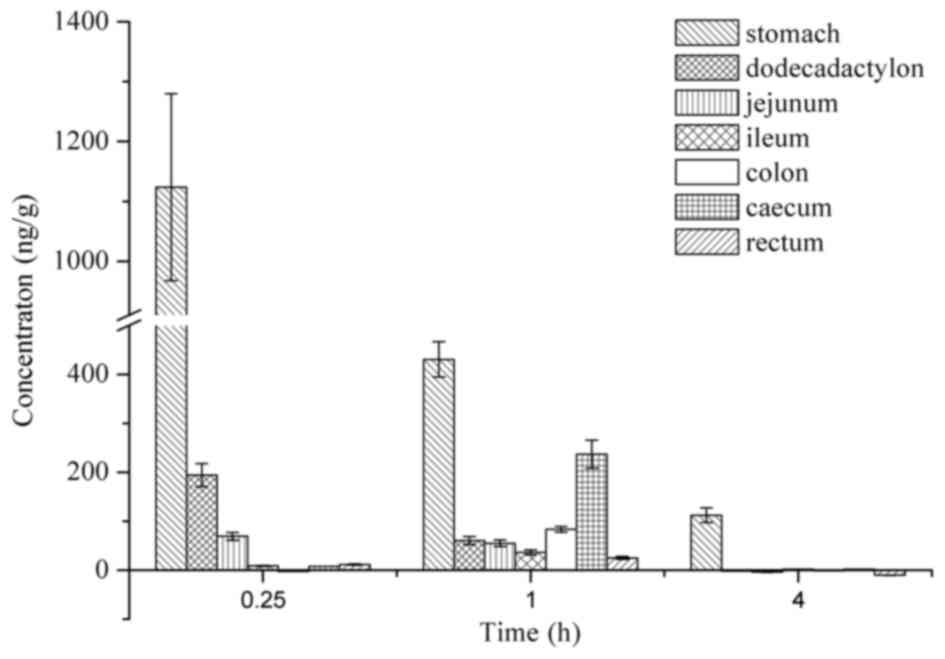Investigation of the cytotoxicity, apoptosis and pharmacokinetics of Raddeanin A
- Authors:
- Published online on: January 11, 2017 https://doi.org/10.3892/ol.2017.5588
- Pages: 1365-1369
Abstract
Introduction
Anemone raddeana of the family Ranunculaceae is a traditional medicine, which was widely used by the Chinese in ancient times to promote the excretion of urine and expel excess gas. At present, with the development of separation and purification techniques, several constituents of Anemone raddeana have been isolated and identified (1), which is convenient for examining the mechanism of single components.
Raddeanin A, a primary triterpenoid saponin extracted from Ranunculaceae Anemone raddeana rhizome (2), has shown antiproliferative effects on human hepatic cancer cells (3). Previous studies have also shown that Raddeanin A induces apoptosis and inhibits invasion in human gastric cancer cells (4), and Raddeanin A has a significant inhibitory effect on the growth of tumor cells, including S180, H22 and U14 cells, in vivo (5). All these activities suggest that Raddeanin A may be a potential compound for the treatment of cancer, and a focus is required on its further investigation and therapeutic application.
However, the inhibitory effect of Raddeanin A on HCT-116 colon cancer cells has not been reported, and few investigations have been performed on the pharmacokinetics and tissue distribution in mice following oral administration of Raddeanin A, which are important in the development of novel drugs (6).
The present study aimed to investigate the inhibitory activity of Raddeanin A on the growth of HCT-116 colon cancer cells. In addition, detailed investigations of the in vivo pharmacokinetic and tissue distribution of Raddeanin A were performed.
Materials and methods
Chemicals and instruments
Raddeanin A (purity >98%) was purchased from the National Institute for the Control of Pharmaceutical and Biological Products (Beijing, China). Digoxin, used as internal standard (IS; purity >98.0%) was obtained from Sichuan Weikeqi Biological Technology Company (Chengdu, China). Formic acid of a liquid chromatography-mass spectrometry (LC-MS) grade was purchased from Sigma-Aldrich (Merck Millipore, Darmstadt, Germany). High performance liquid chromatography (HPLC) gradient grade methanol and acetonitrile were purchased from Merck Millipore. Milli-Q water was produced using a Millipore purification system (EMD Millipore, Billerica, MA, USA). Trypsin-ethylene diamine tetraacetic acid (EDTA) solution (0.25%) was obtained from Biosharp (Hefei, China) and 3-(4,5-dimethylthiazol-2-yl)-2,5-diphenyltetra-zolium bromide (MTT) was purchased from Sigma-Aldrich. An AnnexinV-fluorescein isothiocyanate (FITC)/propidium iodide (PI) detection kit was supplied by BD Biosciences (Franklin Lakes, NJ, USA).
An LC-MS/MS system was used in the present study, the HPLC system consisted of two LC-20AD pumps, a DGU-20A3 degasser, an SIL-20AC auto sampler and a CTO-20AC column oven (Shimadzu Corporation, Kyoto, Japan). The MS was achieved on an API 4000 Q-trap MS/MS system (Applied Biosystems; Thermo Fisher Scientific, Inc., Waltham, MA, USA) equipped with a Turbo Ion Spray inlet in the negative ion mode. Quantification was performed using multiple reaction monitoring mode.
Cell experiments
Cell line and cell cultureThe HCT-116 human colorectal carcinoma cells, obtained from American Type Culture Collection (Manassas, VA, USA), were cultured at 37°C in Dulbecco's modified Eagle's medium (Gibco; Thermo Fisher Scientific, Inc.), supplemented with 10% heat-treated fetal bovine serum (FBS; HyClone; GE Healthcare Life Sciences, Logan, UT, USA), 100 U/ml penicillin and 100 µg/ml streptomycin. The cells were incubated in an atmosphere of 95% air and 5% CO2. The cells were stained by the addition of 0.04% trypan blue to the culture medium to determine cell viability.
MTT assayThe cells were seeded in a 96-well plate at a density of 1×104 cells/0.2 ml/well. Following stabilization overnight, the cells were suspended in serum-free medium with a range of concentrations of Raddeanin A (0.1, 0.5, 1, 5, 10, 50, 100 and 200 µM). Following treatment for 12, 24 and 48 h, MTT (20 µl; 5 mg/ml; Sigma-Aldrich; Merck Millipore) was added into each well and the plates were placed in a 37°C incubator for 3 h. Following incubation, the medium was discarded and 150 µl DMSO (Sigma-Aldrich; Merck Millipore) was added. The absorbance at a wavelength of 490 nm was measured using a microplate reader (BioTek Instruments, Inc., Winooski, VT, USA).
Cellular uptakeThe HCT-116 cells were seeded at a density of 2×104/ml in a 6-well plate and incubated with Raddeanin A (0.25, 0.5, 1 and 2 µM) for 12, 24 and 48 h at 37°C. On harvesting, the cell culture media were collected for analysis. The cells were harvested using 0.25% Trypsin-EDTA Solution following being washed twice with cooled PBS. The solution was then centrifuged at 1,000 × g for 10 min at 4°C to obtain the precipitates. All samples were stored at −70°C until analysis.
DAPI stainingDAPI, a blue fluorescent dye, preferentially stains double-stranded DNA and produces an enhanced florescence. In the present study, the cells were seeded at a density of 2×104/ml and incubated with Raddeanin A (1 and 3 µM) for 24 h at 37°C. Subsequently, 4% paraformaldehyde was added to fix the cells and, 30 min later, DAPI (5 µg/ml) was added and the plate was incubated at room temperature for 15 min. The cells were then observed under a fluorescent microscope in bright field with a DAPI filter at 200x magnification.
Flow cytometric analysis of levels of apoptosis using AnnexinV-FITC/PI double stainingFollowing treatment of the cells with or without Raddeanin A (1 and 3 µM), ~3×105 cells were harvested. Subsequent to being washed twice with cold PBS, the cells were re-suspended in 500 µl binding buffer, containing 10 mM Hepes/NaOH (pH 7.4), 140 mM NaCl and 2.5 mM CaCl2. Annexin-V (5 µl) and PI (5 µl) were then added, and incubated at room temperature for 15 min in the dark for flow cytometric analysis.
Pharmacokinetic investigations in mice
Sample preparationThe analytical method used was developed and validated in a previous study (7) and was successfully applied in the present study. Samples of plasma from mice used for pharmacokinetic investigation (100 µl) were spiked with 10 µl IS solution (10 µg/ml) and then vortexed for 3 min. Subsequently, 400 µl methanol was added and immediately vortexed for 5 min, followed by centrifugation for 10 min at 12,000 × g at 4°C. A 350 µl volume of the supernatant was then transferred into a separate 1.5 ml centrifuge tube and evaporated to dryness in a vacuum desiccator. The residue was reconstituted in 100 µl methanol-water (50:50, v/v), vortexed for 5 min and then centrifuged at 12,000 × g for 10 min at 4°C. A 5 µl aliquot of the solution was injected into the LC-MS/MS system. Data acquisition was performed using Analyst 1.5.1 software (Applied Biosystems; Thermo Fisher Scientific, Inc.).
Pharmacokinetics investigationA total of 60 BALB/c mice (24–30 g; 30 females and 30 males) aged 6 weeks were used for the pharmacokinetic analyses. Mice were supplied bu the Experimental Animal Center of Yangzhou University (Jiangsu, China). All animals had free access to food and water. All animals were housed in an environmentally controlled breeding room at a temperature of ~25°C under a 12 h light/12 h dark cycle for at least 1 week prior to the start of the experiments. The mice were fasted for 12 h with free access to water prior to each experiment. The present study was approved by the Animal Ethical Committee of Nanjing Tech University (Nanjing, China). The 60 mice were orally administered once with Raddeanin A (1.5 mg/kg). Blood samples were collected into heparinized tubes at 0 h (pro-drug) and at 0.08, 0.17, 0.33, 0.5, 1, 1.5, 2, 3, 4, 6 and 8 h (n=5). The plasma samples were acquired by centrifugation at 3,500 × g for 10 min at 4°C and then stored at −80°C until analysis.
Tissue distribution in miceFor investigating the tissue distribution of Raddeanin A, an additional 20 BALB/c mice (10 females and 10 males; 24–30 g; aged 6 weeks; free access to food and water; Experimental Animal Center of Yangzhou University) were assigned into four groups. Samples of the heart, liver, spleen, lung, kidney, stomach, dodecadactylon, jejunum, ileum, colon, caecum and rectum (~0.2 g) were collected at 0, 0.4, 1 and 4 h (following sacrifice by cervial dislocation) following an oral administration of Raddeanin A solution (1.5 mg/kg). The tissue samples were rinsed with ice-cold saline solution (0.9% NaCl) to remove the blood. All samples were stored at −20°C until LC-MS/MS analysis.
Data analysisPharmacokinetic parameters were calculated using DAS version 2.0 software (Mathematical Pharmacology Professional Committee of China, Shanghai, China). Data are expressed as the mean ± standard deviation. The significance of differences in the data was evaluated using student's t test. P<0.05 was considered to indicate a statistically significant difference. Statistical analysis was performed using SPSS version 16.0 (SPSS, Inc., Chicago, IL, USA).
Results
Cell experiments
MTT assayFollowing treatment of the HCT-116 cells with Raddeanin A for 12, 24 and 48 h, the viability of the cells was assessed using an MTT assay. The results, as shown in Fig. 1, indicated that the inhibitory effect of Raddeanin A on the HCT-116 was dose-dependent and time-independent. When treated with the dose of 5 µM Raddeanin A for 12, 24 and 48 h, the percentages of viable cells declined to 24.19, 17.31 and 8.18%, respectively. The half maximal inhibitory concentration (IC50) values of Raddeanin A on the HCT-16 cells treated for 12, 24 and 48 h were 1.376, 1.441 and 1.424 µM, respectively. According to the results of the MTT assay, 1 and 3 µM of Raddeanin A were selected to for the subsequent DAPI staining and flow cytometric analysis experiments.
Cellular uptakeThe cellular uptake of Raddeanin A was evaluated by co-incubating HCT-116 cells with a range of drug concentrations for 12, 24 and 48 h. As shown in Fig. 2, the results demonstrated that the uptake of Raddeanin A in the HCT-116 cells was dose-dependent, however no time-dependency was observed.
DAPI stainingAs shown in Fig. 3, compared with the nuclei of the untreated cells, which exhibited a round or oval shape and were used as a control, Raddeanin A exerted a marked effect on the induction of cell apoptosis, visible from the occurrence of distinct nuclear morphological changes of apoptosis, including chromatin condensation, shrinkage and apoptotic body formation.
Flow cytometric analysis of apoptosis using AnnexinV-FITC/PI double stainingTo further examine the apoptosis-inducing capability of Raddeanin A quantitatively, flow cytometric analysis was performed. The results (Fig. 4) showed that the percentages of viable, early apoptotic, late apoptotic and necrotic cells altered significantly following treatment with different concentrations of Raddeanin A for 24 h. The total apoptotic ratio reached 41.8% at the concentration of 3 µM, as evidenced by a clear shift from the live cell population to early and late apoptotic cell populations.
Pharmacokinetic investigations in mice
Pharmacokinetic investigationsThe mean plasma concentration-time graph of Raddeanin A is shown in Fig. 5. The major pharmacokinetic parameters of Raddeanin A calculated using a non-compartmental model are presented in Table I. Raddeanin A was absorbed rapidly in vivo, with a time to maximum concentration of 0.33 h. The concentrations detected in the plasma were low, with a maximum concentration of 12.326 µg/l. This was consistent with a previous study (7), in which low bioavailability of Raddeanin A was demonstrated. In addition, Raddeanin A showed fast elimination with a half-life of 3.542±0.158 h and was undetectable in the plasma at 6 h.
Tissue distributionThe in vivo distribution of Raddeanin A was examined by the quantitative detection of the levels of Raddeanin A in different tissues (Fig. 6). Following oral administration, Raddeanin A was detected in various gastrointestinal tract tissues, namely the stomach, dodecadactylon, jejunum, ileum, colon, caecum and rectum. The highest level of Raddeanin A was observed in the stomach, followed by the colon and the caecum. At 4 h, Raddeanin A was almost undetectable in any of the intestinal tract. In terms of the distribution of Raddeanin A in the blood perfused organs, including the heart, liver, spleen, lung and kidney, the drug levels were not sufficient to be detected using the method used. This was predominantly due to the low absorption of Raddeanin A in the plasma following oral administration, as described above.
Discussion
In ancient time, traditional Chinese medicines were widely used. Investigations have demonstrated the association between the structure of triterpene saponin and its anticancer activities (8) and Raddeanin A, as a triterpene saponin, was one of the primary active components. However, there are no reports on its apoptosis-inducing effect on HCT-116 human colon cancer cells. In addition the cellular uptake patterns of Raddeanin A have not been reported. In the present study, a validated LC-MS/MS method was used to examine cellular uptake, and pharmacokinetic investigations were performed.
In the cell experiments, Raddeanin A was observed to inhibit the proliferation of HCT-116 cells in a dose dependent manner. The IC50 was 1.413 µM, which was lower, compared with that reported in a previous study on human gastric cancer cells (4). DAPI staining and flow cytometric analysis of apoptosis demonstrated the apoptosis-inducing effect of Raddeanin A on the HCT-116 cells. The cellular uptake of Raddeanin A in the HCT-116 cells occurred in a dose-dependent manner.
The pharmacokinetic and tissue distribution characteristics of Raddeanin A were measured in mice. In the pharmacokinetic investigations, a previously developed validated analytical method was utilized to successfully detect the concentrations in mice plasma. The results showed the rapid distribution and elimination of Raddeanin A, which was in agreement with a previous study, which indicated that low bioavailability leads to low concentrations in plasma (7). By contrast, examination of the tissue distribution in the present study demonstrated that Raddeanin A was predominantly distributed in the gastrointestinal tract. Considering its effective antiproliferative activity on human colon cancer cells, Raddeanin A is a promising candidate for the treatment of superficial gastrointestinal cancer.
The present study demonstrated that the Raddeanin A from Ranunculaceae Anemone raddeana induced the apoptosis of HCT-116 cells, which, to the best of our knowledge, has not been reported previously. The uptake of Raddeanin A in HCT-116 was investigated, and the result showed dose-dependency. Additionally, the determination of Raddeanin A in mouse intestinal tissues demonstrated that Raddeanin A was predominantly distributed in the stomach, followed by the cecum and colon. The cell experiments and pharmacokinetic investigations performed support the use of Raddeanin A as a potential oral drug for the treatment of superficial colon cancer in the future. As saponin injection has several harmful adverse effects, including hemolysis (9), the exploitation of a non-injectable formulation for Raddeanin A is necessary.
Acknowledgements
This study was supported by the State Key Laboratory of Materials-Oriented Chemical Engineering, Nanjing Tech University (grant no. KL14-08) and the National Science and Technology Major Projects for ‘Major New Drugs Innovation and Development’ (grant no. 2013ZX09103001-004).
References
|
Cao P, Wu FE and Ding LS: Advances in the studies on the chemical constituents and biologic activities for anemone species. Nat Prod Res Dev. 16:581–584, 520. 2004. | |
|
Zhang JM, Cao L and Wu ZM: Studies on anticancer activities of triterpenoid in Anemone raddeana Regel. Chinese J New Drugs. 12:191–193. 2003.(In Chinese). | |
|
Ma M, Li DL, Zhao DY, et al: Study the effect of raddeanin A on the proliferation of human hepatic cancer in nude mice. Drug Eval Res. 01:40–43. 2015.(In Chinese). | |
|
Xue G, Zou X, Zhou JY, Sun W, Wu J, Xu JL and Wang RP: Raddeanin A induces human gastric cancer cells apoptosis and inhibits their invasion in vitro. Biochem Biophys Res Commun. 439:196–202. 2013. View Article : Google Scholar : PubMed/NCBI | |
|
Wang MK, Ding LS and Wu FE: Antitumor effects of raddeanin A on S180, H22 and U14 cell xenografts in mice. Ai Zheng. 27:910–913. 2008.(In Chinese). PubMed/NCBI | |
|
Sun C, Li Q, Pan L, Liu B, Gu P, Zhang J, Ding L and Wu C: Development of a highly sensitive LC-MS/MS method for simultaneous determination of rupatadine and its two active metabolites in human plasma: Application to a clinical pharmacokinetic study. J Pharm Biomed Anal. 111:163–168. 2015. View Article : Google Scholar : PubMed/NCBI | |
|
Liu Y, Ma B, Zhang Q, Ying H, Li J, Xu Q, Wu D and Wang Y: Development and validation of a sensitive liquid chromatography/tandem mass spectrometry method for the determination of raddeanin A in rat plasma and its application to a pharmacokinetic study. J Chromatogr B Analyt Technol Biomed Life Sci. 912:16–23. 2013. View Article : Google Scholar : PubMed/NCBI | |
|
Cao J, Li W, Tang Y, Zhang X, Li W and Zhao Y: Three new triterpene saponins from Actinostemma lobatum MAXIM and their cytotoxicity in vitro. Phytochem Lett. 11:301–305. 2015. View Article : Google Scholar | |
|
Zhou HL, Shun YX, Li Y, Wang B and Liu DY: Progress in Studies on Chemical Constituents and Pharmacological Effect of Anemone raddeana Regel. Lisizhen Medicine and Materia Medica Research. 05:1239–1241. 2007.(In Chinese). |



